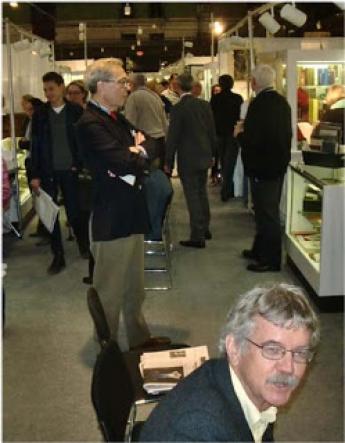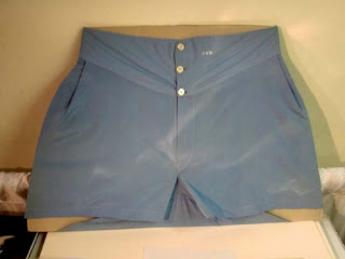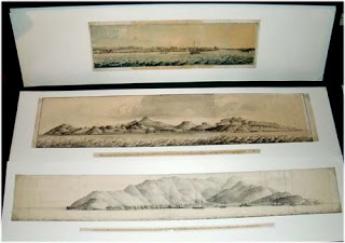Antiquarian Booksellers' Association of America Ten Pound Island Book Company
Of Apes and Underwear

By Greg Gibson
As I was getting ready to depart for New York last Monday I received a most interesting email.
“Greg Gibson,
Are you looking for something in our Mystery, Thriller & Suspense books department? If so, you might be interested in these items …”
Amazon, at the apogee of its algorithmical perfection, was soliciting me to buy my own book: The Old Turk’s Load.
That afternoon, having arrived in the Big Apple, I went down to the Mysterious Bookshop to sign some copies of The Old Turk’s Load. These, I am proud to report, were bound to Poisoned Pen which had selected the book for their prestigious First Mystery Club (Mysterious also selected the Turk for their - at least as prestigious and similarly named - First Mystery Club) Lo and Behold, Mysterious Bookshop, in its new location, turned out to be right across the street from the Raccoon Lodge, a Tribeca bar at which I spent more than a few wild evenings back in the 1980s, “researching” future New York-based crime novels. Though I didn’t know it at the time and, actually, can’t remember it very well now.
Meanwhile, back at the Armory, setup for the 53rd Annual New York International Antiquarian Book Fair was proceeding smoothly.
And, I am happy to report, the show opened to what felt like record crowds. I think reduced opening night admission and a more generous free ticket policy had a noticeable effect.
Unfortunately, sales did not match the crowd size. By Sunday afternoon, almost all the dealers I spoke with reported decent, but not spectacular, fairs.
It may be, as Jeff Marks and Jennifer Larson suggest, that the continued ascent of the auction rooms is having a negative effect. Jennifer writes, “The degree to which the growing plethora of pre-fair big-ticket auctions sucks oxygen out of the New York Book Fair is undetermined.” Kevin MacDonnell later reported “seven auctions held before the NY bookfair that broke $1m (copied from AE's weekly auction report) -- this does not include the countless auctions that didn't reach $1m... Every dollar spent in those venues was a dollar that was not spent at the bookfair.”
It may also be that most of the material on the floor was just too damned expensive. Down the aisle from my stand was a cubic foot of books that literally changed western civilization – the famed Columbus Letter, in which the noted explorer announced the discovery of America, and Copernicus’ De Revolutionibus Orbium Coelestium, in which the noted astronomer announced the fact that the Church had it wrong (about the sun, anyway).
The Columbus Letter was priced at $1.3 million and Copernicus, if I remember correctly, at $2.5 million. Even with a generous discount (the Columbus Letter is a maritime book, after all) I wasn’t going to be buying either of those. They were pretty much the high end, but as I walked the aisles I noted no shortage of five and six figure items.
This, of course, makes the four figure books on my shelves seem insignificant. But it also means that replacing them, at least in a venue like the New York fair, is going to be difficult. It’s getting harder for me to buy from the trade at this show, and the material that I do buy is often priced too high for a quick resale to other dealers. (This is called “flipping” and, while it still occurs, the frequency of occurrence is diminishing at my level.)
As it becomes increasingly difficult to buy from the trade for resale to the trade, we lower tier dealers become increasingly dependent on retail and institutional sales. This is a precarious position for us small fry. Just think of a three-legged stool missing a leg.
At the same time, one gets the feeling that there’s something else going on out there. But, to quote the Buffalo Springfield, “what is it ain’t exactly clear.”
This year, more than ever before, many of the books on the floor, particularly the extraordinary stock of the more than eighty European dealers who exhibited, seemed more like antiques or fine art than books. This is something I’ve been yammering about for quite a while.
In the digital age, books have surrendered their primary function as containers of information. They are now items that, while still conveying the traditional uses and values of the book, have moved into the class of antiquities. They have become “objects of desire.” That Columbus Letter was originally meant to serve the same purpose as a newspaper. Now it is more like the Mona Lisa.
To be truly worthy of note, books at this event had to be as much artifacts as collections of words. And if they weren’t cultural monuments like Columbus, Copernicus, or hundreds of other items that graced the shelves of the more spectacular booths, they had better be visually arresting, or unique, or in impossibly fine condition, or they wouldn’t attract the attention of any but the most dedicated librarians and collectors. (Who, happily, were present and diligent enough that most of us got home with sufficient accounts receivable to feed our starveling chilluns.)
In the old days I’d pack my booth with as many as 300 books. Now I only bring a couple of dozen, supplemented by broadsides, photographs, and manuscripts.
Should it surprise anyone that this year’s New York “Book” Fair also brought us a giant ape from Paris, and a pair of Eugene O’Neill’s underwear?
Here’s one the librarians and collectors missed:
TEN COASTAL VIEWS DRAWN IN THE LESSER ANTILLES, SANTO DOMINGO, AND VENEZUELA BY MIDSHIPMAN H.C. NOWELL, HMS SCAMANDER, 1817-1818.
An expertly rendered series of ten views of ports and islands, including Martinique, Grenada, St. Vincent, Trinidad, St. Kitts, Santo Domingo, and Cumana in Venezuela. With manuscript captions. Most are done in ink and pencil; one is in ink and watercolor. They vary in size between 5 - 8 1/2 inches tall and 17 1/2 - 37 3/4 inches in length. Some show minor professional repairs, and all have been corner mounted on archival board covered by a protective mylar sheet. Many Royal Navy officers of this era were skilled draftsmen, having been instructed in mechanical drawing and map making as part of their training. However, Nowell stands above his contemporaries. What are nominally Recognition Views (standard navigation aids frequently sketched by sailors) become works of art under his hand.
Housed in green cloth clamshell box measuring 12 1/2 x 40 1/2 inches, with leather cover labels. $20,000
And, as a final note, I'm happy to announce that I sold over 100 copies of The Old Turk's Load to colleagues and friends at the book fair. All profits are bound for the ABAA Benevolent Fund.
Thank you, generous readers!
(Posted on Bookman’s Log. Presented hery by permission of the author.)



